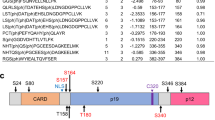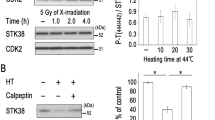Abstract
Many pro-apoptotic signals activate caspase-9, an initiator protease that activates caspase-3 and downstream caspases to initiate cellular destruction1. However, survival signals can impinge on this pathway and suppress apoptosis. Activation of the Ras–Raf–MEK–ERK mitogen-activated protein kinase (MAPK) pathway is associated with protection of cells from apoptosis and inhibition of caspase-3 activation2,3,4,5, although the targets are unknown. Here, we show that the ERK MAPK pathway inhibits caspase-9 activity by direct phosphorylation. In mammalian cell extracts, cytochrome c-induced activation of caspases-9 and -3 requires okadaic-acid-sensitive protein phosphatase activity. The opposing protein kinase activity is overcome by treatment with the broad-specificity kinase inhibitor staurosporine or with inhibitors of MEK1/2. Caspase-9 is phosphorylated at Thr 125, a conserved MAPK consensus site targeted by ERK2 in vitro, in a MEK-dependent manner in cells stimulated with epidermal growth factor (EGF) or 12-O-tetradecanoylphorbol-13-acetate (TPA). Phosphorylation at Thr 125 is sufficient to block caspase-9 processing and subsequent caspase-3 activation. We suggest that phosphorylation and inhibition of caspase-9 by ERK promotes cell survival during development and tissue homeostasis. This mechanism may also contribute to tumorigenesis when the ERK MAPK pathway is constitutively activated.
This is a preview of subscription content, access via your institution
Access options
Subscribe to this journal
Receive 12 print issues and online access
$209.00 per year
only $17.42 per issue
Buy this article
- Purchase on Springer Link
- Instant access to full article PDF
Prices may be subject to local taxes which are calculated during checkout





Similar content being viewed by others
References
Budihardjo, I., Oliver, H., Lutter, M., Luo, X. & Wang, X. Biochemical pathways of caspase activation during apoptosis. Annu. Rev. Cell Dev. Biol. 15, 269–290 (1999).
Xia, Z., Dickens, M., Raingeaud, J., Davis, R.J. & Greenberg, M.E. Opposing effects of ERK and JNK-p38 MAP kinases on apoptosis. Science 270, 1326–1331 (1995).
Erhardt, P., Schremser, E.J. & Cooper, G.M. B-Raf inhibits programmed cell death downstream of cytochrome c release from mitochondria by activating the MEK/Erk pathway. Mol. Cell. Biol. 19, 5308–5315 (1999).
Le Gall, M. et al. The p42/p44 MAP kinase pathway prevents apoptosis induced by anchorage and serum removal. Mol. Biol. Cell 11, 1103–1112 (2000).
von Gise, A. et al. Apoptosis suppression by Raf-1 and MEK1 requires MEK- and phosphatidylinositol 3-kinase-dependent signals. Mol. Cell. Biol. 21, 2324–2336 (2001).
Jacobson, M.D., Weil, M. & Raff, M.C. Programmed cell death in animal development. Cell 88, 347–354 (1997).
Zou, H., Henzel, W.J., Liu, X., Lutschg, A. & Wang, X. Apaf-1, a human protein homologous to C. elegans CED-4, participates in cytochrome c-dependent activation of caspase-3. Cell 90, 405–413 (1997).
Acehan, D. et al. Three-dimensional structure of the apoptosome: implications for assembly, procaspase-9 binding, and activation. Mol. Cell 9, 423–432 (2002).
Cecconi, F., Alvarez-Bolado, G., Meyer, B.I., Roth, K.A. & Gruss, P. Apaf1 (CED-4 homolog) regulates programmed cell death in mammalian development. Cell 94, 727–737 (1998).
Yoshida, H. et al. Apaf1 is required for mitochondrial pathways of apoptosis and brain development. Cell 94, 739–750 (1998).
Hakem, R. et al. Differential requirement for caspase 9 in apoptotic pathways in vivo. Cell 94, 339–352 (1998).
Kuida, K. et al. Reduced apoptosis and cytochrome c-mediated caspase activation in mice lacking caspase 9. Cell 94, 325–337 (1998).
Soengas, M.S. et al. Apaf-1 and caspase-9 in p53-dependent apoptosis and tumor inhibition. Science 284, 156–159 (1999).
Soengas, M.S. et al. Inactivation of the apoptosis effector Apaf-1 in malignant melanoma. Nature 409, 207–211 (2001).
Wang, X., Martindale, J.L., Liu, Y. & Holbrook, N.J. The cellular response to oxidative stress: influences of mitogen-activated protein kinase signalling pathways on cell survival. Biochem. J. 333, 291–300 (1998).
Rytömaa, M., Lehmann, K. & Downward, J. Matrix detachment induces caspase-dependent cytochrome c release from mitochondria: inhibition by PKB/Akt but not Raf signalling. Oncogene 19, 4461–4468 (2000).
MacKeigan, J.P., Collins, T.S. & Ting, J.P. MEK inhibition enhances paclitaxel-induced tumor apoptosis. J. Biol. Chem. 275, 38953–38956 (2000).
Tashker, J.S., Olson, M. & Kornbluth, S. Post-cytochrome c protection from apoptosis conferred by a MAPK pathway in Xenopus egg extracts. Mol. Biol. Cell 13, 393–401 (2002).
Li, P. et al. Cytochrome c and dATP-dependent formation of Apaf-1–caspase-9 complex initiates an apoptotic protease cascade. Cell 91, 479–489 (1997).
Clarke, P.R. in Apoptosis: The Molecular Biology of Programmed Cell Death (eds Jacobson, M.D. & McCarthy, N.) 176–199 (Oxford University Press, Oxford, 2002).
Davies, S.P., Reddy, H., Caivano, M. & Cohen, P. Specificity and mechanism of action of some commonly used protein kinase inhibitors. Biochem. J. 351, 95–105 (2000).
Jiang, X. & Wang, X. Cytochrome c promotes caspase-9 activation by inducing nucleotide binding to Apaf-1. J. Biol. Chem. 275, 31199–31203 (2000).
Hu, Y., Ding, L., Spencer, D.M. & Nunez, G. WD-40 repeat region regulates Apaf-1 self-association and procaspase-9 activation. J. Biol. Chem. 273, 33489–33494 (1998).
Srinivasula, S.M., Ahmad, M., Fernandes-Alnemri, T. & Alnemri, E.S. Autoactivation of procaspase-9 by Apaf-1-mediated oligomerization. Mol. Cell 1, 949–957 (1998).
Cardone, M.H. et al. Regulation of cell death protease caspase-9 by phosphorylation. Science 282, 1318–1321 (1998).
Mody, N., Leitch, J., Armstrong, C., Dixon, J. & Cohen, P. Effects of MAP kinase cascade inhibitors on the MKK5/ERK5 pathway. FEBS Lett. 502, 21–24 (2001).
Bergmann, A., Tugentman, M., Shilo, B.Z. & Steller, H. Regulation of cell number by MAPK-dependent control of apoptosis: a mechanism for trophic survival signaling. Dev. Cell 2, 159–170 (2002).
Bergmann, A., Agapite, J., McCall, K. & Steller, H. The Drosophila gene hid is a direct molecular target of Ras-dependent survival signaling. Cell 95, 331–341 (1998).
Kurada, P. & White, K. Ras promotes cell survival in Drosophila by downregulating hid expression. Cell 95, 319–329 (1998).
Sapkota, G.P. et al. Phosphorylation of the protein kinase mutated in Peutz-Jeghers cancer syndrome, LKB1/STK11, at Ser431 by p90(RSK) and cAMP-dependent protein kinase, but not its farnesylation at Cys(433), is essential for LKB1 to suppress cell growth. J. Biol. Chem. 276, 19469–19482 (2001).
Acknowledgements
We are grateful to D. Alessi for reagents and discussion, and S. Keyse for critical reading of the manuscript. Initial studies on the inhibition of caspase activation by okadaic acid were performed by S. Cosulich and P. Savory. This work was supported by Cancer Research UK, the Medical Research Council and the Association for International Cancer Research.
Author information
Authors and Affiliations
Corresponding author
Ethics declarations
Competing interests
The authors declare no competing financial interests.
Supplementary information
41556_2003_BFncb1005_MOESM1_ESM.pdf
Figure S1. Inhibition of protein phosphatase activity in cell extracts blocks caspase-9 activation in a MEK-dependent manner. (PDF 204 kb)
Rights and permissions
About this article
Cite this article
Allan, L., Morrice, N., Brady, S. et al. Inhibition of caspase-9 through phosphorylation at Thr 125 by ERK MAPK. Nat Cell Biol 5, 647–654 (2003). https://doi.org/10.1038/ncb1005
Received:
Accepted:
Published:
Issue Date:
DOI: https://doi.org/10.1038/ncb1005
This article is cited by
-
Electric field modulation of ERK dynamics shows dependency on waveform and timing
Scientific Reports (2024)
-
Targeting the RAS/RAF/MAPK pathway for cancer therapy: from mechanism to clinical studies
Signal Transduction and Targeted Therapy (2023)
-
Momordica charantia Inhibits Prostate Cancer Cell Proliferation by Suppressing Dihydrotestosterone-Induced Caspase-9 Phosphorylation
Iranian Journal of Science (2023)
-
How does caspases regulation play role in cell decisions? apoptosis and beyond
Molecular and Cellular Biochemistry (2023)
-
An EHMT2/NFYA-ALDH2 signaling axis modulates the RAF pathway to regulate paclitaxel resistance in lung cancer
Molecular Cancer (2022)



